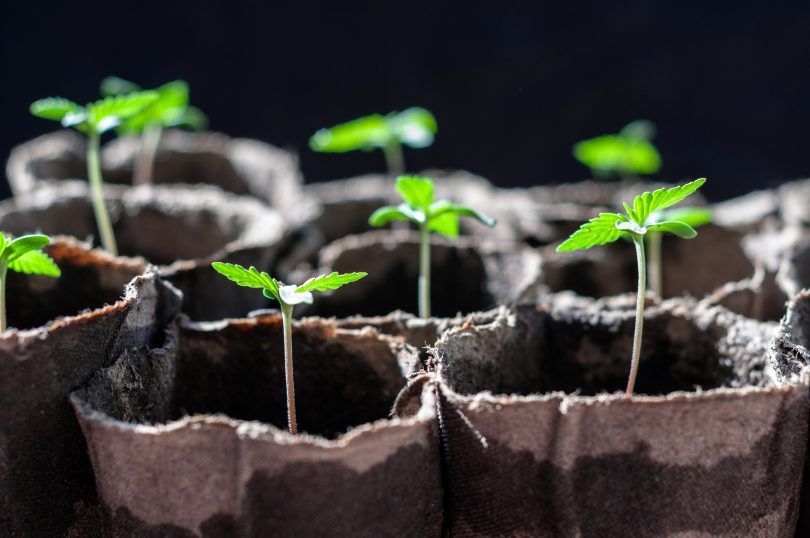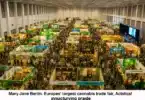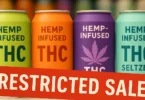Smokable hemp is very similar to marijuana. In biology, both plants are closely related. They even share the same Cannabis genus.
However, hemp is differentiated from marijuana through the amount of THC it contains. Legally, a hemp is defined as any Cannabis strains with dried flowers that contain less than 0.3% THC. Among fans, smokable hemp is prized for its high content of other active compounds including higher concentrations of CBG, CBN, and CBD. Learn more about different strains of cannabis here.
In the United States, production of smokable hemp flower and smokable hemp products has been federally legal since 2018. However, farmers and traders are specifically compelled to abide by various agricultural laws on the state level and the 2014 U.S. Agricultural Act.
Farming smokable hemp flower does not require any specialized machineries. Most of the time, the required machines are equipment that are commonly required in farming of other crops. Smokable hemp is farmed similar to how vines and other perennial types crops are cultivated, which also calls for both orchard type of cultivation.
In this article, we hope to equip you with the basic knowledge to how to cultivate smokable. Hopefully, if this is your first time embarking in smokable hemp cultivation, this article can help you start your business.
CLICK HERE or use the sign-up form below to subscribe to the CBD Flowers Weekly Newsletter.
How to plant your smokable hemp
In case you decide to plant your smokable smokable hemp indoors like in a greenhouse or purely inside a building with artificial lights, you have an incredible freedom to choose whatever season to plant your crops. However, for people who choose to set up a backyard garden, learning about the right season to plant your smokable hemp seeds is an essential knowledge to have.
The ideal outdoor temperature for smokable hemp to grow is between 60–80 °F (16–27 °C). As such, the best time to plant smokable hemp seeds is in late spring, just after the last frost has melted. Before planting your seeds, measure the temperature of the soil at 1 inch (2.5 cm) deep with a soil thermometer. Plant your seed only when you are sure that it is above 50 °F (10 °C). Measure at consecutive days to determine if the temperature has been consistent for a few days. Only then can you plant your smokable hemp seeds.
Smokable hemp has specific needs when it comes to the soil. As such, before planting your pant, it is important that you prepare your soil. If you can find a place that already has the requirement of to grow healthy crops, then this is much better since it is easier to locate a garden with optimum soil conditions rather than trying to correct an existing soil that has the wrong consistency, mineral content and pH for smokable hemp to grow.
Smokable hemp is the type of plant that grows well with well-aerated soil. You can introduce aeration into your soil by breaking up the chunks of soil on the surface. You can do this using a hoe or tiller.
Make sure also that soil is well drained. Soil that does not drain well can cause damage to the root system and the trunk of your plants. You can examine how well or poorly drained your soil by digging a 1 × 1 × 1 ft (30 × 30 × 30 cm) hole on the surface. Filling this up with water and time the length of time it takes for the water to completely drain. A soil that keeps the water longer than 1 hour is not a poorly drained soil. You can correct the soil drainage by replacing the top soil with copious amount of well-drained soil. If you cannot do this, perhaps it is cheaper to relocate your garden.

The seeds should be planted in 3⁄4–1 1⁄4 inches (1.9–3.2 cm) deep of soil. You can use your hands or seed drill attached to a lawnmower or tractor to properly plant and space the crops. Just follow how the equipment is used and you should be okay.
To guide you in the spacing of seeds, please remember that for hemp that are planted for their fiber planting the seeds closer together is the norm. The close proximity of the plants will force your crops to grow taller as they compete for the plant. This way, you will be able to harvest longer fibers. For smokable hemp crops that are planted for their seeds, it is best to spread the seeds farther apart from each other. Doing so will induce the smokable hemps to widely branch out. They also tend to grow shorter when you do this.
Make sure to water your crops throughout their growing season. However, keep in mind to always check the moisture of the soil. You can do this by sticking your finger down to the first knuckle into the soil. If the soil feels dry when you do this, you can water you’re the soil until it is damp at around 1–2 inches (2.5–5.1 cm) deep. Watering is crucial during the first 6 weeks of growing,
Use fertilizers if necessary. When choosing fertilizers, choose something that is high in nitrogen. It is advisable to apply fertilizers when the weather is warm and dry, in this kind of weather, fertilizers do not stick to the plants. Never apply fertilizers to the seed. Apply fertilizers once just as soon as when the seeds have germinated.
You can add fertilizers in between the rows of smokable hemp. Avoid directly applying them on the plants. Make sure to water your crops as soon as you stop with the application of the fertilizer. This way, the soil absorbs the fertilizers better.
How to harvest the fibers from your crop
The flowers are not the only things you can harvest from your smokable hemp. You can also get strong natural hemp fiber from your crops. After harvesting the buds, what is left are the stalks that have been removed with their buds. These stalks are not completely useless. You can still harvest and process these for their natural fibers. The fibers are excellent for making various things like rope, hats, and other items at home. You can also sell them to various companies.
As soon as your crops begin to develop their own seeds, you can cut the stalk using a sickle. Make sure to cut the stalk as close to the ground as possible. This way, you can get the most fibers from your crops. For people with smaller gardens, a handheld sickle is enough.

Fiber is taken directly from the fiber. But you cannot get the fiber as soon as you have harvested your crops. What you need to do is to leave the stalks of your harvested crops in the field for a maximum of 5 weeks. The stalks should be laid on top of each other. Doing this will allow both the natural moisture of the plants and microbes to destroy the hard shell of the trunk. The moisture and microbes will separate the bonds between the individual fibers of the smokable hemp. This could take up to 5 weeks until the plants are slightly rotten. This process is called retting.
After retting, you can now dry the stalks of the plants in a cold and dry area. You can help speed up the process by separating the individual fibers from each other. Dry the crops until the moisture level is 15% using a moisture meter. The fibers are good for harvesting once they have dried up to 15%. A decorator is commonly used to separate the fibers of the smokable hemp. The fibers from the smokable hemp will come out of the machine ready for selling.
How to induce the crops to flower
The flowering stage is the phase in your crops’ life cycle when your plants begin to produce flowers. This is characterized by the development of very aromatic and soon-to-be-smokable flower buds. This is a crucial stage in the development of your crops. If you are planting your smokable hemp to produce smokable buds, it is important for a home grower such as yourself to learn more on how to take care of your plants through every week of the flowering stage.
The reason why you choose the late spring to plant your crops is to ensure that by the time autumn comes, your plant will receive as longer hours of uninterrupted darkness. This longer light hours induce the plants to enter into their flowering stage. When you grow indoors, you can induce flowering stage by switch off the artificial lights for 10-12 hours.
The flowering period for smokable hemp usually lasts from 7 to 9 weeks, depending on the varieties that you have.
The first week of flowering cycle is marked by rapid growth in your plants. Expect your crops to grow almost double in height. While growing rapidly, the crops will also grow more new leaves at the top of their main colas. By the second week, white pistils will begin to grow if your hemp are female. The pistils will later become your flower buds. Male hemps will never grow pistils. Instead, expect small pollen sac to grow.
At this stage, you can successfully sex your plants so you can separate the males from the females. The females will be harvested for their buds while the males will be allowed to grow to pollinate some of your female crops so you can have seeds to harvest. Also during this time, you will have to increase the flowering nutrients for your crops. This will help your plants reach their maximum yield potential.
Check for potential problems in your plant. Discoloration and yellowing of leaves or loss of leaves may be signs of an underlying problem. Signs of overfeeding, also known as nutrient burn, is diagnosed through discoloration of leaves.
Your crops will stop growing by the fourth week. The flower buds grow bigger and fatter everyday. By this week, you will notice the development of trichomes, which produces the distinctive odor of your crops. You can lay low in attentiveness at this time.
Check when your plants are ready for harvesting. A jeweler’s loupe or a small microscope is usually used to check your plants’ trichomes. Find out if your trichomes have turned from clear to a milky white. When most of the trichomes have changed their colors from clear to amber, it means the buds are to be harvested.
How to harvest the seeds
Harvesting seeds is important for the continuation of your crops in the next growing cycle. It is very sustainable to allow some of your crops to continue bearing seed pods way after their flowering period so you can ensure you do not have to buy seeds the next cycle.

At the 16th week of growing, just after the flowering stage, the seeds of the smokable hemp plants are ready for harvesting. By this time some of your crops have been harvested already for their aromatic buds and trichomes.
You need to ensure that the seeds and seed pods are matured before harvesting them. If you harvest them too early, the seeds will be too immature that they will not have chance to grow wen planted. To make sure that seeds are ready for harvesting, the seed pods near the flowers should be hard to the touch. A good indication to check the hardness of the crops is when most of the leaves have already fallen off of the stalk.
To harvest the seed pods, you need to cut the branch just below the lowest seed pod of your hemp. Separate the seeds from the pod by threshing it. With tarp on the ground, you need to hold the stems of your crop with your non dominant hand. Using your dominant hand, hit the seed pods with a stick really hard. This will separate the seeds from the pods. The tarp will act as the catchment area of the seeds. You can easily collect the seeds with the tarp.
Final thoughts
As the market continues to develop and regulate, and prices keep on fluctuating, many people are making the choice to grow their own smokable hemp flowers at home.
Aside from saving money, you can have complete control over what goes into or onto your plants. No pesticides, herbicides, or any nasties if you grow it that way.
Have any more helpful tips? Leave us a note in the comment section below.
For more stories like this one, subscribe to the CBD Flowers Weekly Newsletter.







